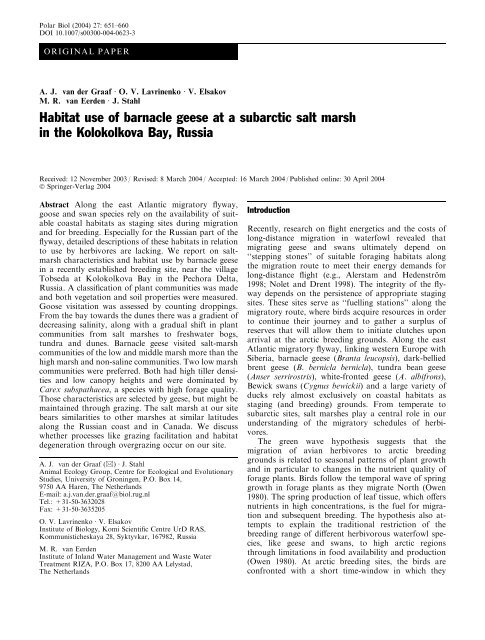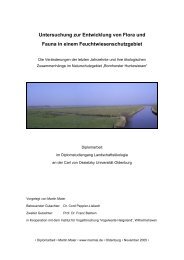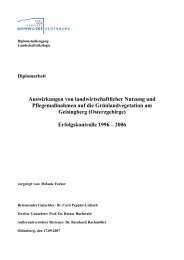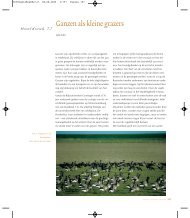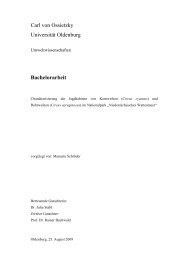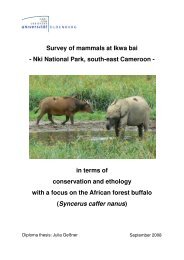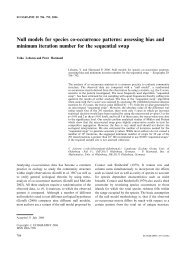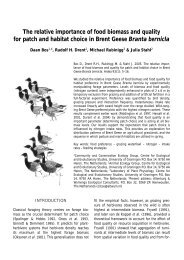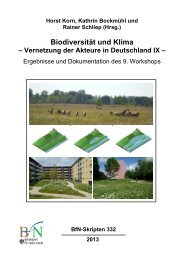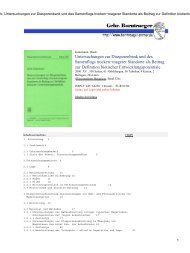Habitat use of barnacle geese at a subarctic salt marsh in the ...
Habitat use of barnacle geese at a subarctic salt marsh in the ...
Habitat use of barnacle geese at a subarctic salt marsh in the ...
You also want an ePaper? Increase the reach of your titles
YUMPU automatically turns print PDFs into web optimized ePapers that Google loves.
Polar Biol (2004) 27: 651–660<br />
DOI 10.1007/s00300-004-0623-3<br />
ORIGINAL PAPER<br />
A. J. van der Graaf Æ O. V. Lavr<strong>in</strong>enko Æ V. Elsakov<br />
M. R. van Eerden Æ J. Stahl<br />
<strong>Habit<strong>at</strong></strong> <strong>use</strong> <strong>of</strong> <strong>barnacle</strong> <strong>geese</strong> <strong>at</strong> a <strong>subarctic</strong> <strong>salt</strong> <strong>marsh</strong><br />
<strong>in</strong> <strong>the</strong> Kolokolkova Bay, Russia<br />
Received: 12 November 2003 / Revised: 8 March 2004 / Accepted: 16 March 2004 / Published onl<strong>in</strong>e: 30 April 2004<br />
Ó Spr<strong>in</strong>ger-Verlag 2004<br />
Abstract Along <strong>the</strong> east Atlantic migr<strong>at</strong>ory flyway,<br />
goose and swan species rely on <strong>the</strong> availability <strong>of</strong> suitable<br />
coastal habit<strong>at</strong>s as stag<strong>in</strong>g sites dur<strong>in</strong>g migr<strong>at</strong>ion<br />
and for breed<strong>in</strong>g. Especially for <strong>the</strong> Russian part <strong>of</strong> <strong>the</strong><br />
flyway, detailed descriptions <strong>of</strong> <strong>the</strong>se habit<strong>at</strong>s <strong>in</strong> rel<strong>at</strong>ion<br />
to <strong>use</strong> by herbivores are lack<strong>in</strong>g. We report on <strong>salt</strong><strong>marsh</strong><br />
characteristics and habit<strong>at</strong> <strong>use</strong> by <strong>barnacle</strong> <strong>geese</strong><br />
<strong>in</strong> a recently established breed<strong>in</strong>g site, near <strong>the</strong> village<br />
Tobseda <strong>at</strong> Kolokolkova Bay <strong>in</strong> <strong>the</strong> Pechora Delta,<br />
Russia. A classific<strong>at</strong>ion <strong>of</strong> plant communities was made<br />
and both veget<strong>at</strong>ion and soil properties were measured.<br />
Goose visit<strong>at</strong>ion was assessed by count<strong>in</strong>g dropp<strong>in</strong>gs.<br />
From <strong>the</strong> bay towards <strong>the</strong> dunes <strong>the</strong>re was a gradient <strong>of</strong><br />
decreas<strong>in</strong>g sal<strong>in</strong>ity, along with a gradual shift <strong>in</strong> plant<br />
communities from <strong>salt</strong> <strong>marsh</strong>es to freshw<strong>at</strong>er bogs,<br />
tundra and dunes. Barnacle <strong>geese</strong> visited <strong>salt</strong>-<strong>marsh</strong><br />
communities <strong>of</strong> <strong>the</strong> low and middle <strong>marsh</strong> more than <strong>the</strong><br />
high <strong>marsh</strong> and non-sal<strong>in</strong>e communities. Two low <strong>marsh</strong><br />
communities were preferred. Both had high tiller densities<br />
and low canopy heights and were dom<strong>in</strong><strong>at</strong>ed by<br />
Carex subsp<strong>at</strong>hacea, a species with high forage quality.<br />
Those characteristics are selected by <strong>geese</strong>, but might be<br />
ma<strong>in</strong>ta<strong>in</strong>ed through graz<strong>in</strong>g. The <strong>salt</strong> <strong>marsh</strong> <strong>at</strong> our site<br />
bears similarities to o<strong>the</strong>r <strong>marsh</strong>es <strong>at</strong> similar l<strong>at</strong>itudes<br />
along <strong>the</strong> Russian coast and <strong>in</strong> Canada. We discuss<br />
whe<strong>the</strong>r processes like graz<strong>in</strong>g facilit<strong>at</strong>ion and habit<strong>at</strong><br />
degener<strong>at</strong>ion through overgraz<strong>in</strong>g occur on our site.<br />
A. J. van der Graaf (&) Æ J. Stahl<br />
Animal Ecology Group, Centre for Ecological and Evolutionary<br />
Studies, University <strong>of</strong> Gron<strong>in</strong>gen, P.O. Box 14,<br />
9750 AA Haren, The Ne<strong>the</strong>rlands<br />
E-mail: a.j.van.der.graaf@biol.rug.nl<br />
Tel.: +31-50-3632028<br />
Fax: +31-50-3635205<br />
O. V. Lavr<strong>in</strong>enko Æ V. Elsakov<br />
Institute <strong>of</strong> Biology, Komi Scientific Centre UrD RAS,<br />
Kommunisticheskaya 28, Syktyvkar, 167982, Russia<br />
M. R. van Eerden<br />
Institute <strong>of</strong> Inland W<strong>at</strong>er Management and Waste W<strong>at</strong>er<br />
Tre<strong>at</strong>ment RIZA, P.O. Box 17, 8200 AA Lelystad,<br />
The Ne<strong>the</strong>rlands<br />
Introduction<br />
Recently, research on flight energetics and <strong>the</strong> costs <strong>of</strong><br />
long-distance migr<strong>at</strong>ion <strong>in</strong> w<strong>at</strong>erfowl revealed th<strong>at</strong><br />
migr<strong>at</strong><strong>in</strong>g <strong>geese</strong> and swans ultim<strong>at</strong>ely depend on<br />
‘‘stepp<strong>in</strong>g stones’’ <strong>of</strong> suitable forag<strong>in</strong>g habit<strong>at</strong>s along<br />
<strong>the</strong> migr<strong>at</strong>ion route to meet <strong>the</strong>ir energy demands for<br />
long-distance flight (e.g., Alerstam and Hedenstro¨ m<br />
1998; Nolet and Drent 1998). The <strong>in</strong>tegrity <strong>of</strong> <strong>the</strong> flyway<br />
depends on <strong>the</strong> persistence <strong>of</strong> appropri<strong>at</strong>e stag<strong>in</strong>g<br />
sites. These sites serve as ‘‘fuell<strong>in</strong>g st<strong>at</strong>ions’’ along <strong>the</strong><br />
migr<strong>at</strong>ory route, where birds acquire resources <strong>in</strong> order<br />
to cont<strong>in</strong>ue <strong>the</strong>ir journey and to g<strong>at</strong>her a surplus <strong>of</strong><br />
reserves th<strong>at</strong> will allow <strong>the</strong>m to <strong>in</strong>iti<strong>at</strong>e clutches upon<br />
arrival <strong>at</strong> <strong>the</strong> arctic breed<strong>in</strong>g grounds. Along <strong>the</strong> east<br />
Atlantic migr<strong>at</strong>ory flyway, l<strong>in</strong>k<strong>in</strong>g western Europe with<br />
Siberia, <strong>barnacle</strong> <strong>geese</strong> (Branta leucopsis), dark-bellied<br />
brent <strong>geese</strong> (B. bernicla bernicla), tundra bean <strong>geese</strong><br />
(Anser serrirostris), white-fronted <strong>geese</strong> (A. albifrons),<br />
Bewick swans (Cygnus bewickii) and a large variety <strong>of</strong><br />
ducks rely almost exclusively on coastal habit<strong>at</strong>s as<br />
stag<strong>in</strong>g (and breed<strong>in</strong>g) grounds. From temper<strong>at</strong>e to<br />
<strong>subarctic</strong> sites, <strong>salt</strong> <strong>marsh</strong>es play a central role <strong>in</strong> our<br />
understand<strong>in</strong>g <strong>of</strong> <strong>the</strong> migr<strong>at</strong>ory schedules <strong>of</strong> herbivores.<br />
The green wave hypo<strong>the</strong>sis suggests th<strong>at</strong> <strong>the</strong><br />
migr<strong>at</strong>ion <strong>of</strong> avian herbivores to arctic breed<strong>in</strong>g<br />
grounds is rel<strong>at</strong>ed to seasonal p<strong>at</strong>terns <strong>of</strong> plant growth<br />
and <strong>in</strong> particular to changes <strong>in</strong> <strong>the</strong> nutrient quality <strong>of</strong><br />
forage plants. Birds follow <strong>the</strong> temporal wave <strong>of</strong> spr<strong>in</strong>g<br />
growth <strong>in</strong> forage plants as <strong>the</strong>y migr<strong>at</strong>e North (Owen<br />
1980). The spr<strong>in</strong>g production <strong>of</strong> leaf tissue, which <strong>of</strong>fers<br />
nutrients <strong>in</strong> high concentr<strong>at</strong>ions, is <strong>the</strong> fuel for migr<strong>at</strong>ion<br />
and subsequent breed<strong>in</strong>g. The hypo<strong>the</strong>sis also <strong>at</strong>tempts<br />
to expla<strong>in</strong> <strong>the</strong> traditional restriction <strong>of</strong> <strong>the</strong><br />
breed<strong>in</strong>g range <strong>of</strong> different herbivorous w<strong>at</strong>erfowl species,<br />
like <strong>geese</strong> and swans, to high arctic regions<br />
through limit<strong>at</strong>ions <strong>in</strong> food availability and production<br />
(Owen 1980). At arctic breed<strong>in</strong>g sites, <strong>the</strong> birds are<br />
confronted with a short time-w<strong>in</strong>dow <strong>in</strong> which <strong>the</strong>y
652<br />
have to lay eggs, <strong>in</strong>cub<strong>at</strong>e and raise <strong>the</strong>ir young. It is<br />
extremely important for young birds to be able to<br />
forage on high-quality veget<strong>at</strong>ion <strong>in</strong> order to ga<strong>in</strong><br />
sufficient weight to undertake <strong>the</strong> southward migr<strong>at</strong>ion<br />
to <strong>the</strong> temper<strong>at</strong>e w<strong>in</strong>ter<strong>in</strong>g grounds (Gadallah and<br />
Jefferies 1995; Piedboeuf and Gauthier 1999; Person<br />
et al. 2003). Accord<strong>in</strong>g to <strong>the</strong> hypo<strong>the</strong>sis, <strong>the</strong> quality <strong>of</strong><br />
food on <strong>of</strong>fer from <strong>the</strong> peak stand<strong>in</strong>g crop <strong>in</strong> summer<br />
<strong>in</strong> more temper<strong>at</strong>e regions would be <strong>in</strong>sufficient to<br />
support <strong>the</strong> requirements <strong>of</strong> <strong>the</strong> birds and <strong>the</strong>ir young.<br />
However, <strong>the</strong> recent expansion <strong>of</strong> <strong>the</strong> breed<strong>in</strong>g range <strong>of</strong><br />
a variety <strong>of</strong> goose species seems to contradict this<br />
hypo<strong>the</strong>sis. A species th<strong>at</strong> recently expanded its<br />
breed<strong>in</strong>g range from <strong>the</strong> high Arctic to a wide range <strong>of</strong><br />
habit<strong>at</strong>s <strong>in</strong> sub-arctic and temper<strong>at</strong>e regions is <strong>the</strong><br />
<strong>barnacle</strong> goose (Van der Jeugd et al. 2003). In this<br />
study, we <strong>use</strong> <strong>the</strong> <strong>barnacle</strong> goose as a model to<br />
understand <strong>the</strong> habit<strong>at</strong> <strong>use</strong> <strong>of</strong> herbivorous migr<strong>at</strong>ory<br />
birds <strong>at</strong> a <strong>subarctic</strong> stag<strong>in</strong>g and breed<strong>in</strong>g site.<br />
Although <strong>salt</strong> <strong>marsh</strong>es are key habit<strong>at</strong>s <strong>in</strong> <strong>the</strong> life<br />
cycle <strong>of</strong> small avian herbivores like <strong>geese</strong>, our knowledge<br />
<strong>of</strong> <strong>salt</strong> <strong>marsh</strong>es around <strong>the</strong> Arctic Circle <strong>of</strong> <strong>the</strong><br />
Old World rema<strong>in</strong>s fragmentary. While several <strong>salt</strong><br />
<strong>marsh</strong>es <strong>in</strong> <strong>the</strong> Canadian and North American Arctic<br />
are well described (Jefferies 1977; Jefferies et al. 1979;<br />
V<strong>in</strong>ce and Snow 1984; K<strong>in</strong>cheloe and Stehn 1991),<br />
descriptions <strong>of</strong> <strong>the</strong> <strong>salt</strong> <strong>marsh</strong>es along <strong>the</strong> Russian part<br />
<strong>of</strong> <strong>the</strong> east Atlantic flyway are ei<strong>the</strong>r lack<strong>in</strong>g, or not<br />
accessible <strong>in</strong> Western liter<strong>at</strong>ure. In this study, we <strong>at</strong>tempt<br />
to fill this gap by describ<strong>in</strong>g different plant<br />
communities and <strong>the</strong>ir characteristics and mapp<strong>in</strong>g <strong>the</strong><br />
zon<strong>at</strong>ion <strong>of</strong> a <strong>salt</strong> <strong>marsh</strong> <strong>at</strong> an important stopover and<br />
breed<strong>in</strong>g site for migr<strong>at</strong><strong>in</strong>g <strong>geese</strong> <strong>in</strong> <strong>the</strong> Pechora Delta<br />
<strong>in</strong> Arctic Russia. We give special <strong>at</strong>tention to habit<strong>at</strong><br />
<strong>use</strong> by <strong>barnacle</strong> <strong>geese</strong>, as <strong>the</strong> area forms one <strong>of</strong> <strong>the</strong><br />
westernmost breed<strong>in</strong>g sites for <strong>the</strong> Russian popul<strong>at</strong>ion<br />
<strong>of</strong> this species.<br />
M<strong>at</strong>erials and methods<br />
Study site<br />
Fieldwork was carried out near <strong>the</strong> village <strong>of</strong> Tobseda<br />
(68°35.296¢N, 52°18.183¢E), <strong>in</strong> Kolokolkova Bay on <strong>the</strong><br />
west coast <strong>of</strong> <strong>the</strong> Pechora Delta (Fig. 1). The pen<strong>in</strong>sula,<br />
where <strong>the</strong> village <strong>of</strong> Tobseda is situ<strong>at</strong>ed, borders <strong>the</strong><br />
Pomorsky Channel <strong>of</strong> <strong>the</strong> Barentz Sea to <strong>the</strong> north and<br />
<strong>the</strong> Kambalnichya Pakha Gulf <strong>of</strong> Kolokolkova Bay to<br />
<strong>the</strong> south (Fig. 1). It is a low coastal terrace, which is<br />
be<strong>in</strong>g formed <strong>in</strong> two parallel ways: first, from <strong>the</strong> sea<br />
side due to <strong>the</strong> accumul<strong>at</strong>ion <strong>of</strong> sand along <strong>the</strong> open<br />
coast as a result <strong>of</strong> abrasion <strong>of</strong> <strong>the</strong> shore and sea<br />
bottom and, second, from <strong>the</strong> Kolokolkova Bay as a<br />
result <strong>of</strong> <strong>the</strong> sediment<strong>at</strong>ion <strong>of</strong> clayey deposits transported<br />
<strong>in</strong>to <strong>the</strong> bay by <strong>the</strong> Neruta River. A dune system<br />
has developed along <strong>the</strong> maritime terrace and <strong>salt</strong><br />
<strong>marsh</strong>es have established along <strong>the</strong> shores <strong>of</strong><br />
Kolokolkova Bay.<br />
The groundw<strong>at</strong>er depth <strong>in</strong> <strong>the</strong>se <strong>marsh</strong>es is shallow<br />
and, <strong>the</strong>refore, <strong>the</strong> groundw<strong>at</strong>er sal<strong>in</strong>ity is <strong>of</strong>ten similar<br />
to th<strong>at</strong> <strong>of</strong> seaw<strong>at</strong>er. Mov<strong>in</strong>g from <strong>the</strong> Kolokolkova Bay<br />
<strong>in</strong> <strong>the</strong> direction <strong>of</strong> <strong>the</strong> dunes, <strong>the</strong> <strong>marsh</strong>es become less<br />
sal<strong>in</strong>e and gradually turn <strong>in</strong>to sedge-moss bogs where<br />
freshw<strong>at</strong>er conditions prevail. With<strong>in</strong> <strong>the</strong> <strong>marsh</strong>es, <strong>the</strong>re<br />
are a number <strong>of</strong> small w<strong>at</strong>er bodies differ<strong>in</strong>g <strong>in</strong> sal<strong>in</strong>ity.<br />
The <strong>salt</strong> <strong>marsh</strong>es are potentially <strong>of</strong> gre<strong>at</strong> importance<br />
for migr<strong>at</strong><strong>in</strong>g <strong>geese</strong> and swans. S<strong>at</strong>ellite telemetry shows<br />
th<strong>at</strong> dark-bellied brent <strong>geese</strong> <strong>use</strong> <strong>the</strong> area as a stopover<br />
site dur<strong>in</strong>g spr<strong>in</strong>g migr<strong>at</strong>ion (Syroechkovsky and Litv<strong>in</strong><br />
1998; Green et al. 2002). On <strong>the</strong> return migr<strong>at</strong>ion <strong>in</strong><br />
autumn, <strong>the</strong> area aga<strong>in</strong> serves as an important stag<strong>in</strong>g<br />
post (Van Eerden 2000). On earlier expeditions (1996,<br />
1997), large numbers <strong>of</strong> <strong>barnacle</strong> <strong>geese</strong>, tundra bean<br />
<strong>geese</strong>, white-fronted <strong>geese</strong> and Bewick swans were observed<br />
<strong>in</strong> <strong>the</strong>se <strong>marsh</strong>es (Van Eerden 2000). In <strong>the</strong> past<br />
decade, <strong>the</strong> area has developed as a breed<strong>in</strong>g area for<br />
<strong>barnacle</strong> <strong>geese</strong> (Syroechkovsky 1995; Van der Jeugd<br />
et al. 2003), probably as an outcome <strong>of</strong> a reduction <strong>in</strong><br />
human disturbance, s<strong>in</strong>ce <strong>the</strong> nearby village was abandoned.<br />
Veget<strong>at</strong>ion classific<strong>at</strong>ion and mapp<strong>in</strong>g<br />
Veget<strong>at</strong>ion descriptions were made <strong>in</strong> 48 plots <strong>of</strong> 4·4 m.<br />
All species <strong>of</strong> vascular plants, mosses and lichens were<br />
recorded, follow<strong>in</strong>g <strong>the</strong> plant nomencl<strong>at</strong>ure <strong>of</strong> Czerepanov<br />
(1995). The abundance <strong>of</strong> all species was recorded<br />
by estim<strong>at</strong><strong>in</strong>g <strong>the</strong>ir percentage cover. The veget<strong>at</strong>ion<br />
descriptions were arranged <strong>in</strong> groups <strong>of</strong> plots with differ<strong>in</strong>g<br />
species and/or comb<strong>in</strong><strong>at</strong>ions <strong>of</strong> species with a high<br />
percentage cover. The result<strong>in</strong>g classific<strong>at</strong>ion m<strong>at</strong>ched<br />
th<strong>at</strong> <strong>of</strong> Leskov (1936), describ<strong>in</strong>g coastal <strong>salt</strong>-<strong>marsh</strong><br />
communities <strong>of</strong> <strong>the</strong> Barentz sea.<br />
Us<strong>in</strong>g this classific<strong>at</strong>ion (Table 1), we determ<strong>in</strong>ed<br />
<strong>salt</strong>-<strong>marsh</strong> veget<strong>at</strong>ion zon<strong>at</strong>ion along four transects,<br />
which were established on different parts <strong>of</strong> <strong>the</strong> <strong>salt</strong><br />
<strong>marsh</strong> <strong>in</strong> <strong>the</strong> summer <strong>of</strong> 2002 and were considered as<br />
four <strong>in</strong>dependent replic<strong>at</strong>es (Fig. 1). Transects ran perpendicular<br />
to <strong>the</strong> coastl<strong>in</strong>e <strong>in</strong> order to map zon<strong>at</strong>ion<br />
from <strong>the</strong> low <strong>salt</strong>-dom<strong>in</strong><strong>at</strong>ed <strong>marsh</strong>es to <strong>the</strong> dunes.<br />
Transects were 50 m wide and transects 1–4 were<br />
respectively 890, 1130, 1280 and 770 m <strong>in</strong> length.<br />
Transects were situ<strong>at</strong>ed <strong>at</strong> least 500 m apart from each<br />
o<strong>the</strong>r and were numbered from northwest to sou<strong>the</strong>ast.<br />
Transect 1 was close to <strong>the</strong> (abandoned) village, transect<br />
2 was loc<strong>at</strong>ed <strong>in</strong> <strong>the</strong> goose breed<strong>in</strong>g area and transects<br />
3 and 4 were placed towards <strong>the</strong> east. Transect 4<br />
was higher <strong>in</strong> elev<strong>at</strong>ion than transect 3 and also traversed<br />
ano<strong>the</strong>r small breed<strong>in</strong>g colony.<br />
In order to determ<strong>in</strong>e <strong>the</strong> veget<strong>at</strong>ion zon<strong>at</strong>ion with<strong>in</strong><br />
each transect, we walked a l<strong>in</strong>e-transect <strong>of</strong> 50 m width,<br />
with five people evenly spaced over <strong>the</strong> entire width <strong>of</strong><br />
<strong>the</strong> transect. The transect led from <strong>the</strong> <strong>in</strong>tertidal fl<strong>at</strong> to<br />
<strong>the</strong> dunes; and <strong>the</strong> plant community was recorded by<br />
every person every 10 m, us<strong>in</strong>g <strong>the</strong> classific<strong>at</strong>ion <strong>in</strong><br />
Table 1.
653<br />
Fig. 1 Loc<strong>at</strong>ion <strong>of</strong> <strong>the</strong> Pechora<br />
Delta area, <strong>the</strong> village <strong>of</strong><br />
Tobseda and <strong>the</strong> transects<br />
with<strong>in</strong> <strong>the</strong> study area. The<br />
figure is based on Lands<strong>at</strong><br />
images (1995/1996)<br />
Measurements<br />
For each plant community with<strong>in</strong> each transect, goose<br />
dropp<strong>in</strong>gs were counted. Dropp<strong>in</strong>g counts were done<br />
mid-July 2002. We assumed th<strong>at</strong> we counted only<br />
dropp<strong>in</strong>gs from <strong>the</strong> same season and th<strong>at</strong> dropp<strong>in</strong>g<br />
numbers thus reflected <strong>the</strong> <strong>use</strong> <strong>of</strong> <strong>the</strong> area <strong>in</strong> th<strong>at</strong> year.<br />
Rest<strong>in</strong>g piles were discarded. Dropp<strong>in</strong>g counts were<br />
made us<strong>in</strong>g two different methods and were repe<strong>at</strong>ed ten<br />
times with<strong>in</strong> each veget<strong>at</strong>ion type for each transect <strong>in</strong><br />
randomly chosen plots. When dropp<strong>in</strong>gs were abundant,<br />
we counted dropp<strong>in</strong>gs <strong>in</strong> plots <strong>of</strong> 4 m 2 . When dropp<strong>in</strong>g<br />
density was low, we counted plots <strong>of</strong> 10 m 2 . Densities<br />
were expressed as x dropp<strong>in</strong>gs m )2 . For all plant communities<br />
with dropp<strong>in</strong>g densities higher than 1 dropp<strong>in</strong>g<br />
m )2 , we measured tiller density (three replic<strong>at</strong>es, each <strong>of</strong><br />
25 cm 2 ), percentage <strong>of</strong> grazed tillers (three replic<strong>at</strong>es,<br />
each <strong>of</strong> 25 cm 2 ) and canopy height (five measurements,<br />
to <strong>the</strong> nearest 0.5 cm), us<strong>in</strong>g a sward stick with a styr<strong>of</strong>oam<br />
disc (20 cm diameter, 24 g). In addition, for each<br />
<strong>of</strong> <strong>the</strong> plant communities along transects 1, 2 and 3,<br />
veget<strong>at</strong>ion cover was estim<strong>at</strong>ed <strong>in</strong> ten randomly selected<br />
plots <strong>of</strong> 4 m 2 . Additionally, we collected samples <strong>of</strong><br />
leaftips (approxim<strong>at</strong>ely 3 cm) from <strong>the</strong> most abundant<br />
plant species for chemical analysis <strong>of</strong> forage quality.<br />
Table 3 shows <strong>the</strong> number <strong>of</strong> replic<strong>at</strong>es for each species.<br />
Samples were dried <strong>at</strong> 60°C for 48 h and <strong>the</strong>reafter<br />
ground and analysed for nitrogen and carbon content,<br />
us<strong>in</strong>g an autom<strong>at</strong>ed CNHS analyser (autom<strong>at</strong>ed element<br />
analysis, Interscience EA 1110).<br />
In order to estim<strong>at</strong>e <strong>the</strong> stand<strong>in</strong>g crop, samples <strong>of</strong><br />
aboveground biomass were taken <strong>in</strong> all plant communities<br />
for all transects <strong>at</strong> 21–25 July 2002. In each plant<br />
community, we sampled <strong>the</strong> upper 2–3 cm <strong>of</strong> soil,<br />
<strong>in</strong>clud<strong>in</strong>g <strong>the</strong> litter layer. We collected three or four<br />
round turves with a diameter <strong>of</strong> 16.6 cm <strong>in</strong> each plant<br />
community. In stands <strong>of</strong> Salix reptans, <strong>the</strong> aboveground<br />
biomass <strong>of</strong> willow was cut from an area <strong>of</strong> 1 m 2 . Green<br />
biomass was cut, sorted and dried to a constant weight<br />
<strong>at</strong> 70°C.
654<br />
Table 1 Veget<strong>at</strong>ion cover <strong>of</strong> <strong>the</strong> plant communities on <strong>marsh</strong>es, comb<strong>in</strong>ed with a table <strong>of</strong> <strong>the</strong> frequency and cover <strong>of</strong> vascular plants. Roman numerals <strong>in</strong>dic<strong>at</strong>e frequency: I1%,+
655<br />
In order to measure electric conductivity, surface<br />
w<strong>at</strong>er was sampled ei<strong>the</strong>r <strong>in</strong> <strong>the</strong> root zone <strong>of</strong> plants<br />
(Hippuris tetraphylla, Carex mackenzeii, Dupontia<br />
psilosantha communities) or <strong>in</strong> pools th<strong>at</strong> were present<br />
<strong>in</strong> <strong>the</strong> <strong>marsh</strong> (all o<strong>the</strong>r plant communities; sample sizes<br />
are mentioned <strong>in</strong> Table 1). Soil samples were collected<br />
<strong>in</strong> <strong>the</strong> root<strong>in</strong>g zone <strong>of</strong> plants (0–8 cm), dried to a<br />
constant weight <strong>at</strong> 70°C and homogenised us<strong>in</strong>g a<br />
porcela<strong>in</strong> mortar and pistil and sieved with a mesh<br />
width <strong>of</strong> 0.25 mm. Every plant community was sampled<br />
once on each transect where present (Table 2).<br />
The total nitrogen and carbon contents (% dry m<strong>at</strong>ter)<br />
were determ<strong>in</strong>ed by gas chrom<strong>at</strong>ography on an autom<strong>at</strong>ed<br />
nitrogen/carbon analyser (ANA-1500) <strong>at</strong> <strong>the</strong><br />
Ecoanalit Labor<strong>at</strong>ory (Institute <strong>of</strong> Biology, Komi<br />
Science Centre, Russia).<br />
To get <strong>in</strong>form<strong>at</strong>ion about <strong>the</strong> <strong>use</strong> <strong>of</strong> <strong>the</strong> area by o<strong>the</strong>r<br />
herbivores, we collected d<strong>at</strong>a on <strong>the</strong> presence <strong>of</strong> o<strong>the</strong>r<br />
herbivorous birds and mammals. Sight<strong>in</strong>gs and counts<br />
<strong>of</strong> birds and mammals were not collected system<strong>at</strong>ically,<br />
but were noted. Dur<strong>in</strong>g 10 days, three l<strong>in</strong>es <strong>of</strong><br />
20 mo<strong>use</strong>traps, baited with carrot and peanut butter,<br />
were set <strong>in</strong> <strong>the</strong> proximity <strong>of</strong> <strong>the</strong> village and transect 1 <strong>in</strong><br />
order to trap small mammals.<br />
The taxonomy <strong>of</strong> bird species follows <strong>the</strong> guidel<strong>in</strong>es<br />
<strong>of</strong> <strong>the</strong> Dutch Commission for Avian System<strong>at</strong>ics<br />
(CSNA).<br />
St<strong>at</strong>istics<br />
As soil and veget<strong>at</strong>ion properties were measured <strong>in</strong> different<br />
plots with different sample sizes, <strong>the</strong>se d<strong>at</strong>a are<br />
not appropri<strong>at</strong>e for detailed st<strong>at</strong>istical analyses. Hence,<br />
<strong>the</strong> results are presented <strong>in</strong> a descriptive manner. All<br />
analyses were performed us<strong>in</strong>g <strong>the</strong> st<strong>at</strong>istical package<br />
SPSS for W<strong>in</strong>dows ver.11.0.1. Barnacle goose dropp<strong>in</strong>g<br />
density was log-transformed to reach normality criteria.<br />
Results<br />
Classific<strong>at</strong>ion <strong>of</strong> <strong>the</strong> veget<strong>at</strong>ion<br />
On basis <strong>of</strong> <strong>the</strong> veget<strong>at</strong>ion classific<strong>at</strong>ion, 11 plant<br />
communities were recognised with<strong>in</strong> <strong>the</strong> <strong>salt</strong> <strong>marsh</strong><br />
(Table 1). Three plant communities not presented <strong>in</strong><br />
Table 1 are <strong>the</strong> D. psilosantha community (a community<br />
with a dom<strong>in</strong>ance <strong>of</strong> D. psilosantha), a community similar<br />
to <strong>the</strong> C. subsp<strong>at</strong>hacea/dicotyledons community with<br />
a dom<strong>in</strong>ance <strong>of</strong> Plantago schrenkii and a community<br />
th<strong>at</strong> we call ‘‘beach wall <strong>in</strong> colony’’. The l<strong>at</strong>ter was situ<strong>at</strong>ed<br />
on an elev<strong>at</strong>ed sandy ridge <strong>at</strong> <strong>the</strong> coast and was<br />
characterised by a low veget<strong>at</strong>ion cover (10%), <strong>of</strong> which<br />
77% <strong>of</strong> <strong>the</strong> cover was gram<strong>in</strong>oids (36% Pucc<strong>in</strong>ellia<br />
phryganodes, 41% C. subsp<strong>at</strong>hacea). The rema<strong>in</strong>der was<br />
P. schrenkii (23%); and many nests <strong>of</strong> <strong>barnacle</strong> <strong>geese</strong><br />
were found <strong>in</strong> this community. Mosses and lichens are<br />
not presented <strong>in</strong> Table 1, although <strong>the</strong>y were recorded as<br />
Table 2 Soil properties (N:C r<strong>at</strong>io <strong>of</strong> sediment, fraction nitrogen <strong>in</strong> sediment, electrical conductivity <strong>of</strong> <strong>the</strong> groundw<strong>at</strong>er) and veget<strong>at</strong>ion properties (total aboveground biomass, tiller<br />
density, veget<strong>at</strong>ion height) <strong>of</strong> all <strong>salt</strong>-<strong>marsh</strong> plant communities. D<strong>at</strong>a given are means ±SE, with sample size given <strong>in</strong> brackets. For tiller density and canopy height, <strong>the</strong> results <strong>of</strong> a posthoc<br />
test are given. Different letters denote significant differences <strong>at</strong> <strong>the</strong> P
656<br />
present, especially <strong>in</strong> <strong>the</strong> Salix reptans/Rhodiola rosea<br />
community.<br />
We divided all non-<strong>salt</strong>-<strong>marsh</strong> plant communities<br />
<strong>in</strong>to <strong>the</strong> follow<strong>in</strong>g habit<strong>at</strong> classes: w<strong>at</strong>er/algae, dune/<br />
sand, bogs and tundra. This sketchy dist<strong>in</strong>ction was<br />
made on <strong>the</strong> basis <strong>of</strong> <strong>in</strong>dic<strong>at</strong>ive species or groups <strong>of</strong><br />
species (Carex aqu<strong>at</strong>ilis, Carex rariflora and mosses for<br />
bog habit<strong>at</strong> class, a substantial cover <strong>of</strong> lichens and<br />
dwarf shrubs for tundra habit<strong>at</strong> class) and substr<strong>at</strong>um.<br />
We subdivided <strong>the</strong> <strong>salt</strong> <strong>marsh</strong> <strong>in</strong>to three habit<strong>at</strong> classes,<br />
based on <strong>the</strong>ir sal<strong>in</strong>ity and loc<strong>at</strong>ion with respect to tidal<br />
<strong>in</strong>und<strong>at</strong>ion (low, middle, high). The communities<br />
belong<strong>in</strong>g to <strong>the</strong> low <strong>salt</strong> <strong>marsh</strong> were <strong>the</strong> most sal<strong>in</strong>e<br />
communities: P. phryganodes/C. subsp<strong>at</strong>hacea, C. subsp<strong>at</strong>hacea/Stellaria<br />
humifusaand <strong>the</strong> beach wall community<br />
<strong>in</strong> <strong>the</strong> colony. Plant communities belong<strong>in</strong>g to<br />
<strong>the</strong> middle high <strong>salt</strong> <strong>marsh</strong> were more brackish communities:<br />
H. tetraphylla, C. mackenziei/Warnstorfia<br />
exannul<strong>at</strong>a, D. psilosantha, C. subsp<strong>at</strong>hacea/dicotyledons,<br />
C. subsp<strong>at</strong>hacea/dicotyledons with P. schrenkii<br />
dom<strong>in</strong>ant and Calamagrostis deschampsioides/Carex<br />
glareosa. The plant communities <strong>of</strong> <strong>the</strong> high <strong>salt</strong><br />
<strong>marsh</strong> were Festuca richardsonii/Parnassia palustrisand<br />
S. reptans/R. rosea.<br />
For all plant communities, <strong>the</strong> total nitrogen content<br />
<strong>of</strong> <strong>the</strong> sediment was very low (
657<br />
species. The quality <strong>of</strong> species differed significantly (oneway<br />
ANOVA F 6,21 =9.378, P
658<br />
<strong>the</strong> <strong>geese</strong> favoured higher veget<strong>at</strong>ion <strong>in</strong> this preferred<br />
plant community where canopy height was generally<br />
low. Overall, <strong>barnacle</strong> <strong>geese</strong> preferred plant communities<br />
with low canopy heights.<br />
O<strong>the</strong>r herbivores<br />
Fig. 3 Cumul<strong>at</strong>ive dropp<strong>in</strong>g densities for <strong>the</strong> most important<br />
veget<strong>at</strong>ion communities. Communities with dropp<strong>in</strong>g densities<br />
lower than 1 dropp<strong>in</strong>g m )2 are left out. Different letters denote<br />
significant differences derived from a post-hoc Tukey test<br />
(P
659<br />
cover <strong>of</strong> ei<strong>the</strong>r P. phryganodes or C. subsp<strong>at</strong>haceaare<br />
preferentially <strong>use</strong>d by forag<strong>in</strong>g <strong>geese</strong>.<br />
As <strong>the</strong> Russian <strong>subarctic</strong> <strong>salt</strong> <strong>marsh</strong> <strong>at</strong> our study site<br />
is heavily <strong>use</strong>d by stag<strong>in</strong>g, breed<strong>in</strong>g and moult<strong>in</strong>g <strong>geese</strong>,<br />
processes similar to those act<strong>in</strong>g <strong>in</strong> La Pe´ro<strong>use</strong> Bay may<br />
play a role: graz<strong>in</strong>g optimis<strong>at</strong>ion <strong>at</strong> modest levels <strong>of</strong><br />
herbivory and habit<strong>at</strong> degener<strong>at</strong>ion <strong>at</strong> high levels due to<br />
overgraz<strong>in</strong>g. At <strong>the</strong> <strong>salt</strong> <strong>marsh</strong> <strong>at</strong> La Pe´ro<strong>use</strong> Bay, lesser<br />
snow <strong>geese</strong> (A. caerulescens caerulescens) <strong>in</strong>crease <strong>the</strong><br />
production, density and nitrogen content <strong>of</strong> <strong>the</strong>ir forage<br />
plants (P. phryganodes, C. subsp<strong>at</strong>hacea) by graz<strong>in</strong>g<br />
(Cargill and Jefferies 1984; Kotanen and Jefferies 1987;<br />
Bazely and Jefferies 1989a). This process is an example<br />
<strong>of</strong> graz<strong>in</strong>g optimis<strong>at</strong>ion and is ca<strong>use</strong>d by an acceler<strong>at</strong>ion<br />
<strong>in</strong> nutrient cycl<strong>in</strong>g as a result <strong>of</strong> graz<strong>in</strong>g and subsequent<br />
fertilis<strong>at</strong>ion <strong>of</strong> <strong>the</strong> veget<strong>at</strong>ion by dropp<strong>in</strong>gs (Bazely and<br />
Jefferies 1985; Hik and Jefferies 1990). The neg<strong>at</strong>ive effects<br />
<strong>of</strong> large numbers <strong>of</strong> herbivores on <strong>the</strong>ir forage<br />
plants, which cumul<strong>at</strong>e dur<strong>in</strong>g habit<strong>at</strong> degener<strong>at</strong>ion, are<br />
<strong>in</strong>iti<strong>at</strong>ed by <strong>the</strong> grubb<strong>in</strong>g <strong>of</strong> lesser snow <strong>geese</strong>. As a result<br />
<strong>of</strong> <strong>the</strong> removal <strong>of</strong> <strong>the</strong> <strong>in</strong>sul<strong>at</strong><strong>in</strong>g m<strong>at</strong> <strong>of</strong> plant m<strong>at</strong>erial,<br />
soil evapor<strong>at</strong>ion <strong>in</strong>creases, which leads to hypersal<strong>in</strong>e<br />
conditions <strong>in</strong> <strong>the</strong> upper layers <strong>of</strong> <strong>the</strong> soil, <strong>the</strong>reby<br />
reduc<strong>in</strong>g <strong>the</strong> growth <strong>of</strong> gram<strong>in</strong>oids (Srivastava and<br />
Jefferies 1996). In grubbed areas, soil nitrogen and its<br />
m<strong>in</strong>eralis<strong>at</strong>ion are decreased which, toge<strong>the</strong>r with <strong>the</strong><br />
hyper-sal<strong>in</strong>e conditions, hamper <strong>the</strong> re-establishment <strong>of</strong><br />
plants (Wilson and Jefferies 1996; Walker et al. 2003).<br />
Unlike <strong>the</strong> snow <strong>geese</strong> <strong>in</strong> <strong>the</strong> Canadian Arctic, <strong>barnacle</strong><br />
<strong>geese</strong> do not forage destructively. They graze <strong>the</strong><br />
aboveground plant m<strong>at</strong>erial and do not grub for<br />
belowground plant parts. At our Russian site, we found<br />
no evidence <strong>of</strong> <strong>the</strong> neg<strong>at</strong>ive effects <strong>of</strong> goose graz<strong>in</strong>g on<br />
<strong>the</strong> gram<strong>in</strong>oid sward and we do not expect habit<strong>at</strong><br />
degener<strong>at</strong>ion as a result <strong>of</strong> goose forag<strong>in</strong>g to play a role<br />
<strong>in</strong> <strong>in</strong>duc<strong>in</strong>g veget<strong>at</strong>ion change <strong>in</strong> this Russian <strong>subarctic</strong><br />
<strong>salt</strong> <strong>marsh</strong>. It is likely, however, th<strong>at</strong> graz<strong>in</strong>g optimis<strong>at</strong>ion<br />
does play a role <strong>in</strong> this <strong>marsh</strong>.<br />
Veget<strong>at</strong>ion selection by <strong>barnacle</strong> <strong>geese</strong><br />
<strong>at</strong> a <strong>subarctic</strong> <strong>marsh</strong><br />
Our d<strong>at</strong>a suggest th<strong>at</strong> <strong>the</strong> <strong>geese</strong> select forage sites on a<br />
comb<strong>in</strong><strong>at</strong>ion <strong>of</strong> <strong>the</strong> forage parameters <strong>of</strong> canopy height,<br />
tiller density and food quality. It is strik<strong>in</strong>g th<strong>at</strong> <strong>the</strong> two<br />
most preferred plant communities both conta<strong>in</strong> <strong>the</strong> two<br />
forage species with highest tissue quality: T. palustre and<br />
C. subsp<strong>at</strong>hacea. The preferred communities also had <strong>the</strong><br />
highest average tiller densities and <strong>the</strong> lowest average<br />
canopy heights. Interest<strong>in</strong>gly, <strong>the</strong>se can ei<strong>the</strong>r be characteristics<br />
selected by <strong>the</strong> <strong>geese</strong>, or <strong>the</strong>y can be ca<strong>use</strong>d by<br />
goose graz<strong>in</strong>g. Graz<strong>in</strong>g reduces canopy height and may<br />
<strong>in</strong>crease tiller density <strong>in</strong> <strong>the</strong> grazed veget<strong>at</strong>ion<br />
(McNaughton 1984; Kotanen and Jefferies 1987; Bazely<br />
and Jefferies 1989a). Dense swards <strong>of</strong> forage plant species<br />
are preferred by <strong>the</strong> <strong>geese</strong>, as <strong>the</strong>y result <strong>in</strong> <strong>in</strong>creased<br />
food <strong>in</strong>take r<strong>at</strong>es (Van der Wal et al. 1998). At <strong>the</strong> same<br />
time, <strong>geese</strong> are known to prefer low canopy heights, as<br />
short swards decrease handl<strong>in</strong>g time and enhance forag<strong>in</strong>g<br />
efficiency (Van der Wal et al. 1998; Hassall et al.<br />
2001; Bos 2002).<br />
For arctic and <strong>subarctic</strong> systems, several studies<br />
demonstr<strong>at</strong>ed th<strong>at</strong> <strong>the</strong> quality <strong>of</strong> <strong>the</strong> veget<strong>at</strong>ion is improved<br />
through graz<strong>in</strong>g (Gauthier et al. 1995; Post and<br />
Kle<strong>in</strong> 1996; Ruess et al. 1997; Fox et al. 1998). The<br />
allevi<strong>at</strong>ion <strong>of</strong> nutrient limit<strong>at</strong>ion <strong>in</strong> <strong>the</strong> veget<strong>at</strong>ion<br />
through <strong>the</strong> addition <strong>of</strong> herbivore faeces plays an<br />
important role <strong>in</strong> this process (Bazely and Jefferies<br />
1989b; Ruess et al. 1997). Future expeditionary work on<br />
<strong>the</strong> Tobseda <strong>marsh</strong> will <strong>in</strong>vestig<strong>at</strong>e nutrient availability<br />
for plant growth <strong>at</strong> th<strong>at</strong> site and <strong>the</strong> role <strong>of</strong> forag<strong>in</strong>g<br />
<strong>geese</strong> with<strong>in</strong> <strong>the</strong> ecosystem processes.<br />
Acknowledgements We thank Ruurd Noordhuis, Go¨ tz Eichhorn,<br />
Henk van der Jeugd, Konstant<strong>in</strong> Litv<strong>in</strong>, Elena Gurtovaya, Oleg<br />
M<strong>in</strong>eev, Kirst<strong>in</strong> Janssen, Svetlana Vavilova and Nikita Lavr<strong>in</strong>enko<br />
for <strong>the</strong>ir support and company dur<strong>in</strong>g this expedition. The Dutch<br />
Institute <strong>of</strong> Inland W<strong>at</strong>er Management and Waste W<strong>at</strong>er Tre<strong>at</strong>ment,<br />
RIZA, and <strong>the</strong> University <strong>of</strong> Gron<strong>in</strong>gen organised and<br />
f<strong>in</strong>ancially supported <strong>the</strong> expedition. We thank Dick Visser for<br />
prepar<strong>in</strong>g <strong>the</strong> figures and Jan Bakker, René van der Wal, Bob<br />
Jefferies and one anonymous referee for valuable comments on<br />
earlier versions <strong>of</strong> <strong>the</strong> manuscript. J.S. was f<strong>in</strong>ancially supported by<br />
<strong>the</strong> Deutsche Forschungsgeme<strong>in</strong>schaft.<br />
References<br />
Alerstam T, Hedenstro¨ m A (1998) The development <strong>of</strong> bird<br />
migr<strong>at</strong>ion <strong>the</strong>ory. J Avian Biol 29:343–369<br />
Bazely DR, Jefferies RL (1985) Goose faeces: a source <strong>of</strong> nitrogen<br />
for plant growth <strong>in</strong> a grazed <strong>salt</strong> <strong>marsh</strong>. J Appl Ecol 22:693–703<br />
Bazely DR, Jefferies RL (1989a) Leaf and shoot demography <strong>of</strong> an<br />
arctic stoloniferous grass Pucc<strong>in</strong>ellia phryganoides <strong>in</strong> response<br />
to graz<strong>in</strong>g. J Ecol 77:811–822<br />
Bazely DR, Jefferies RL (1989b) Lesser snow <strong>geese</strong> and <strong>the</strong> nitrogen<br />
economy <strong>of</strong> a grazed <strong>salt</strong> <strong>marsh</strong>. J Ecol 77:24–34<br />
Bos D (2002) Brent Geese cope with <strong>in</strong>creased levels <strong>of</strong> primary<br />
production <strong>in</strong> spr<strong>in</strong>g by aggreg<strong>at</strong>ion. PhD <strong>the</strong>sis, University <strong>of</strong><br />
Gron<strong>in</strong>gen, Gron<strong>in</strong>gen<br />
Cargill SM, Jefferies RL (1984) The effects <strong>of</strong> graz<strong>in</strong>g by lesser<br />
snow <strong>geese</strong> on <strong>the</strong> veget<strong>at</strong>ion <strong>of</strong> a sub-arctic <strong>salt</strong> <strong>marsh</strong>. J Appl<br />
Ecol 21:669–686<br />
Czerepanov SK (1995) Vascular plants <strong>of</strong> Russia and adjacent<br />
st<strong>at</strong>es (<strong>the</strong> former USSR). Cambridge University Press, Cambridge<br />
Fox AD, Kristiansen JN, Stroud DA, Boyd H (1998) The effects <strong>of</strong><br />
simul<strong>at</strong>ed spr<strong>in</strong>g goose graz<strong>in</strong>g on <strong>the</strong> growth r<strong>at</strong>e and prote<strong>in</strong><br />
content <strong>of</strong> Phleum pr<strong>at</strong>ense leaves. Oecologia 116:154–159<br />
Gadallah FL, Jefferies RL (1995) Forage quality <strong>in</strong> brood rear<strong>in</strong>g<br />
areas <strong>of</strong> <strong>the</strong> lesser snow goose and <strong>the</strong> growth <strong>of</strong> captive gosl<strong>in</strong>gs.<br />
J Appl Ecol 32:276<br />
Gauthier G, Hughes RJ, Reed A, Beaulieu J, Rochefort L (1995)<br />
Effect <strong>of</strong> graz<strong>in</strong>g by gre<strong>at</strong>er snow <strong>geese</strong> on <strong>the</strong> production <strong>of</strong><br />
gram<strong>in</strong>oids <strong>at</strong> an arctic site (Bylot Island, NWT, Canada).<br />
J Ecol 83:653–664<br />
Green M, Alerstam T, Cla<strong>use</strong>n P, Drent RH, Ebb<strong>in</strong>ge BS (2002)<br />
Site <strong>use</strong> by dark-bellied brent <strong>geese</strong> Branta bernicla bernicla on<br />
<strong>the</strong> Russian tundra as recorded by s<strong>at</strong>ellite telemetry: implic<strong>at</strong>ions<br />
for East Atlantic Flyway conserv<strong>at</strong>ion. Wildl Biol 8:229–<br />
239<br />
Hassall M, Ridd<strong>in</strong>gton R, Helden A (2001) Forag<strong>in</strong>g behaviour <strong>of</strong><br />
brent <strong>geese</strong>, Branta b. bernicla, on grasslands: effects <strong>of</strong> sward<br />
length and nitrogen content. Oecologia 127:97–104
660<br />
Hik DS, Jefferies RL (1990) Increases <strong>in</strong> <strong>the</strong> net above-ground<br />
primary production <strong>of</strong> a <strong>salt</strong>-<strong>marsh</strong> forage grass—a test <strong>of</strong> <strong>the</strong><br />
predictions <strong>of</strong> <strong>the</strong> herbivore-optimiz<strong>at</strong>ion model. J Ecol 78:180–<br />
195<br />
Jefferies RL (1977) The veget<strong>at</strong>ion <strong>of</strong> <strong>salt</strong> <strong>marsh</strong>es <strong>at</strong> some coastal<br />
sites <strong>in</strong> arctic North America. J Ecol 65:661–672<br />
Jefferies RL, Jensen A, Abraham KF (1979) Veget<strong>at</strong>ional development<br />
and <strong>the</strong> effect <strong>of</strong> <strong>geese</strong> on veget<strong>at</strong>ion <strong>at</strong> La Pe´ro<strong>use</strong> Bay,<br />
Manitoba. Can J Bot 57:1439–1450<br />
K<strong>in</strong>cheloe KL, Stehn RA (1991) Veget<strong>at</strong>ion p<strong>at</strong>terns and environmental<br />
gradients <strong>in</strong> coastal meadows on <strong>the</strong> Yukon–Kuskokwim<br />
delta, Alaska. Can J Bot 69:1616–1627<br />
Korchag<strong>in</strong> AA (1935) Veget<strong>at</strong>ion <strong>of</strong> maritime alluviums <strong>of</strong> <strong>the</strong><br />
Mezensky Gulf and Chez Bay meadows and meadow bogs (<strong>in</strong><br />
Russian). Acta Inst Bot Acad Sci URSS Ser 3:2223–2333<br />
Kotanen PM, Jefferies RL (1987) The leaf and shoot demography<br />
<strong>of</strong> grazed and ungrazed plants <strong>of</strong> Carex subsp<strong>at</strong>hacea. J Ecol<br />
75:961–976<br />
Leskov AI (1936) Geobotanical essay <strong>of</strong> <strong>the</strong> Malozemelskaya<br />
Tundra coastal <strong>salt</strong> <strong>marsh</strong>es <strong>of</strong> <strong>the</strong> Barentz Sea (<strong>in</strong> Russian).<br />
Bot Zh St Petersburg 21:96–116<br />
McNaughton SJ (1984) Graz<strong>in</strong>g lawns: animals <strong>in</strong> herds, plant<br />
form and coevolution. Am N<strong>at</strong> 124:863–886<br />
Nolet BA, Drent RH (1998) Bewick Swans refuell<strong>in</strong>g on pondweed<br />
tubers <strong>in</strong> <strong>the</strong> Dv<strong>in</strong>a Bay (White Sea) dur<strong>in</strong>g <strong>the</strong>ir spr<strong>in</strong>g<br />
migr<strong>at</strong>ion: first come, first served. J Avian Biol 29:574–581<br />
Owen M (1980) Wild <strong>geese</strong> <strong>of</strong> <strong>the</strong> world. B<strong>at</strong>sford, London<br />
Person BT, Herzog MP, Ruess RW, Sed<strong>in</strong>ger JS, Anthony RM,<br />
Babcock CA (2003) Feedback dynamics <strong>of</strong> graz<strong>in</strong>g lawns:<br />
coupl<strong>in</strong>g veget<strong>at</strong>ion change with animal growth. Oecologia<br />
135:583–592<br />
Piedboeuf N, Gauthier G (1999) Nutritive quality <strong>of</strong> forage plants<br />
for gre<strong>at</strong>er snow goose gosl<strong>in</strong>gs: when is it advantageous to feed<br />
on grazed plants? Can J Zool 77:1908–1918<br />
Post ES, Kle<strong>in</strong> DR (1996) Rel<strong>at</strong>ionships between gram<strong>in</strong>oid growth<br />
form and levels <strong>of</strong> graz<strong>in</strong>g by caribou (Rangifer tarandus) <strong>in</strong><br />
Alaska. Oecologia 107:364–372<br />
Rebristaya OV (1997) Flora <strong>of</strong> <strong>the</strong> seas coast habit<strong>at</strong>s <strong>in</strong> <strong>the</strong> west<br />
Siberian Arctic (<strong>in</strong> Russian). Bot Zh St Petersburg 82:30–40<br />
Ruess RW, Uliassi DD, Mulder CPH, Person BT (1997) Growth<br />
responses <strong>of</strong> Carex ramenskiito defoli<strong>at</strong>ion, sal<strong>in</strong>ity, and<br />
nitrogen availability: implic<strong>at</strong>ions for <strong>geese</strong>-ecosystem dynamics<br />
<strong>in</strong> western Alaska. Ecoscience 4:170–178<br />
Srivastava DS, Jefferies RL (1996) A positive feedback: herbivory,<br />
plant growth, sal<strong>in</strong>ity and <strong>the</strong> desertific<strong>at</strong>ion <strong>of</strong> an Arctic <strong>salt</strong><strong>marsh</strong>.<br />
J Ecol 84:31–42<br />
Srivastava DS, Jefferies RL (2002) Intertidal plant communities <strong>of</strong><br />
an Arctic <strong>salt</strong> <strong>marsh</strong>: <strong>the</strong> <strong>in</strong>fluence <strong>of</strong> isost<strong>at</strong>ic uplift and herbivory.<br />
Ecoscience 9:112–118<br />
Syroechkovsky EE Jr (1995) News <strong>in</strong> distribution <strong>of</strong> Barnacle<br />
Goose <strong>in</strong> Russia (<strong>in</strong> Russian with English summary). Geese<br />
Study Group Bull East Eur North Asia 1:39–46<br />
Syroechkovsky EE Jr, Litv<strong>in</strong> KE (1998) Migr<strong>at</strong>ions <strong>of</strong> Brent <strong>geese</strong><br />
(Branta bernicla bernicla) <strong>in</strong> Russia (<strong>in</strong> Russian with English<br />
summary). Casarca 4:71–95<br />
Van der Jeugd HP, Gurtovaya E, Eichhorn G, Litv<strong>in</strong> KYe, M<strong>in</strong>eev<br />
OY, Van Eerden MR (2003) Breed<strong>in</strong>g <strong>barnacle</strong> <strong>geese</strong> <strong>in</strong> Kolokolkov<br />
Bay, Russia: number <strong>of</strong> breed<strong>in</strong>g pairs, reproductive<br />
success, and morphology. Polar Biol 26:700–706<br />
Van der Wal R, Van de Koppel J, Sagel M (1998) On <strong>the</strong> rel<strong>at</strong>ion<br />
between herbivore forag<strong>in</strong>g efficiency and plant stand<strong>in</strong>g crop:<br />
an experiment with <strong>barnacle</strong> <strong>geese</strong>. Oikos 82:123–130<br />
Van Eerden MR (2000) Pechora Delta—structure and dynamics <strong>of</strong><br />
<strong>the</strong> Pechora Delta ecosystems (1995–1999). Institute for Inland<br />
W<strong>at</strong>er Management and Waste W<strong>at</strong>er Tre<strong>at</strong>ment (RIZA), Lelystad<br />
V<strong>in</strong>ce SW, Snow AA (1984) Plant zon<strong>at</strong>ion <strong>in</strong> an Alaskan <strong>salt</strong><br />
<strong>marsh</strong>—I. Distribution, abundance and environmental factors.<br />
J Ecol 72:651–667<br />
Walker NA, Hendry HAL, Wilson DJ, Jefferies RL (2003) The<br />
dynamics <strong>of</strong> nitrogen movement <strong>in</strong> an Arctic <strong>salt</strong> <strong>marsh</strong> <strong>in</strong> response<br />
to goose herbivory: a parameterized model with altern<strong>at</strong>e<br />
stable st<strong>at</strong>es. J Ecol 91:637–650<br />
Wilson DJ, Jefferies RL (1996) Nitrogen m<strong>in</strong>eraliz<strong>at</strong>ion, plant<br />
growth and goose herbivory <strong>in</strong> an Arctic coastal ecosystem.<br />
J Ecol 84:841–851


